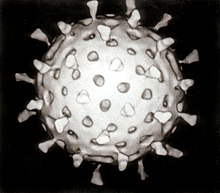Introduction to viruses
| Viruses | |
|---|---|
 |
|
| Computer reconstruction of a rotavirus particle | |
| Scientific classification | |
| Groups | |
|
I: dsDNA viruses |
I: dsDNA viruses
II: ssDNA viruses
III: dsRNA viruses
IV: (+)ssRNA viruses
V: (-)ssRNA viruses
VI: ssRNA-RT viruses
VII: dsDNA-RT viruses
A single, fully functional virus particle outside its host cell
Some viruses have a bubble of fat that surrounds the virion.
A segment of DNA or RNA; genes are like sentences made of the "letters" of the nucleotide alphabet. Genes direct the reproduction of viruses. Different types of viruses have genes made from DNA or RNA but not both.
The animals, plants or bacteria that any one type of virus can infect.
The viruses that reproduce in bacteria
A grouping of viruses based on the antigens on the surface of virus
All viruses of a type are identical and their particles have a cubical, helical or complex structure.
A virus is a biological agent that reproduces inside the cells of living hosts. When infected by a virus, a host cell is forced to produce many thousands of identical copies of the original virus at an extraordinary rate. Unlike most living things, viruses do not have cells that divide; new viruses are assembled in the infected host cell. But unlike still simpler infectious agents, viruses contain genes, which gives them the ability to mutate and evolve. Over 5,000 species of viruses have been discovered.
The origins of viruses are unclear: some may have evolved from plasmids—pieces of DNA that can move between cells—while others may have evolved from bacteria. A virus consists of two or three parts: genes, made from either DNA or RNA, long molecules that carry genetic information; a protein coat that protects the genes; and in some viruses, an envelope of fat that surrounds the protein coat and is used, in combination with specific receptors, to enter a new host cell. Viruses vary in shape from the simple helical and icosahedral to more complex structures. Viruses range in size from 20 to 300 nanometres; it would take 30,000 to 750,000 of them, side by side, to stretch to 1 centimetre (0.39 in).
...
Wikipedia
